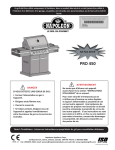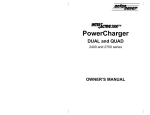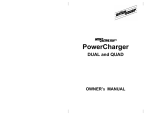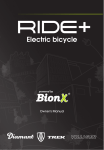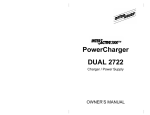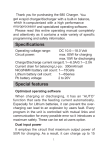Download ProtekRC Prodigy 620 DUO Specifications
Transcript
TABLE OF CONTENTS Introduction......................................................................................................03 Special Features .............................................................................................05 Warning and Safety Notes...............................................................................07 Program Flow Chart ........................................................................................10 Connecting the Charger .................................................................................. 11 Connecting the Battery....................................................................................12 Initial Parameter Setup (Users Setup).............................................................13 Lithium Battery (LiIon/LiPo/LiFe) Program ......................................................15 Charging Lithium Batteries ..............................................................................16 Balance Charging Lithium Batteries ................................................................17 Fast Charging Lithium Batteries ......................................................................18 Charging Lithium Batteries for Storage ...........................................................19 Discharging Lithium Batteries..........................................................................19 Charging NiCd/NiMH Batteries........................................................................20 Discharging NiCd/NiMH Batteries ...................................................................21 Cycling NiCd/NiMH Batteries ..........................................................................21 Charging Lead-Acid (Pb) Batteries..................................................................22 Discharging Lead-Acid (Pb) Batteries .............................................................22 Saving Charge Profiles....................................................................................23 Loading Charge Profiles ..................................................................................24 Additional Charge Information .........................................................................24 Warning and Error Messages..........................................................................25 Recommended Accessories ............................................................................26 Conformity Declaration ....................................................................................27 Maximum Circuit Power Chart.........................................................................28 Specifications ..................................................................................................29 Commonly Used Terms ...................................................................................30 Warranty and Service ......................................................................................30 · 02 INTRODUCTION Thank you for purchasing the Prodigy 620 DUO charger from ProTek R/C. You are now the owner of a professional-level battery management system. The Prodigy 620 DUO is very simple to use, but unlocking the full power of such a capable charger requires some knowledge on the part of the user; these instructions are to help familiarize the user with the features of the charger, as well as how to use them to their fullest capabilities. Please read these instructions, warnings, and safety notes completely before using your new charger. When properly used, the ProTek R/C Prodigy 620 DUO will provide years of performance and service. It can be dangerous to mishandle batteries and battery chargers, as there is a risk of fire or explosion. · 03 INTRODUCTION Left View Smart Fan Power Input (12-18V DC) Output 1 Balancing Port 1 Temperature Sensor 1 Right View Display 1 Large 2x16 LCD for Easy Reading Temperature Balancing Port 2 Sensor 2 Output 2 Smart Fan Output 1 Batt Type/ INC/DEC Stop Button Button Display 2 Large 2x16 LCD for Easy Reading Navigation Buttons Output 2 Enter/Start Batt Type/ INC/DEC Enter/Start Button Stop Button Button Button · 04 SPECIAL FEATURES SET CONTENTS 1 2 3 5 4 1. Prodigy 620 DUO Charger 2. JST-XH Balancing Adaptor (2 Sets) 3. Alligator Clip Charging Cable (1) 4. 18AWG Wire Charging Cable (2) 5. Plug-in Battery Clamps SPECIAL FEATURES Operating software optimized for ease of use and maximum safety The user can adjust each of Prodigy 620 DUO’s settings and parameters. However, the Prodigy 620 DUO also features an AUTO charge function that sets output current during the process of charging or discharging; this can prevent fire or explosion caused by overcharging due to incorrect charger settings, particularly for lithium batteries. If an error is detected at any point in the charger’s operating, the unit will stop the charge or discharge process and an alarm will sound. Integrated lithium battery cell balancer The Prodigy 620 DUO features an individual cell balancer built into the case. There’s no need for an external balancer. Individual cell balance discharging While discharging lithium batteries that have been plugged into the integrated balancing port, the Prodigy 620 DUO can monitor and balance the voltage of each cell individually. The process will end automatically and an error message will indicate if the voltage of any single cell is abnormal. · 05 SPECIAL FEATURES Compatible with all types of lithium batteries The Prodigy 620 DUO is capable of charging various types of lithium batteries, such as LiPo, LiFe, and Li-Ion. Fast charge and storage charge modes for lithium batteries Fast charge alters the rate of change in charge current to reduce the duration of the charging process, while the storage charge mode brings the voltage of the pack to a suitable level for long-term storage. Maximum safety The Prodigy 620 DUO uses Delta-peak sensitivity to automatically terminate the charging process once the battery’s voltage exceeds the specified threshold; this prevents the battery from overcharging. Automatic charging current limit For safety and extra protection against battery damage, a user-determined maximum current limit can be set when charging small-capacity NiCD or NiMH cells with low internal resistance. Capacity limit The charged capacity listed on-screen is calculated by multiplying charging current and charge time. If the charging capacity exceeds this user-specified limit, the process will be terminated automatically. Temperature threshold* The battery's internal chemical reaction during charging or discharging may cause the temperature of the battery to rise. If the user-specified temperature limit is exceeded, the charging process will be terminated automatically. *This function is available by connecting optional temperature probe, not included. Processing time limit The user can set the maximum charge/discharge time. If the time limit is reached, the process will be terminated automatically. Programmable memory The Prodigy 620 DUO can store up to ten (10) different charge/discharge profiles for your convenience. These stored profiles can be recalled quickly, with no additional program required. Continuous charge/discharge cycles The Prodigy 620 DUO can automatically cycle batteries up to 5 times; this is useful for refreshing and balancing old batteries after long-term storage. · 06 WARNING AND SAFETY NOTES These warnings and safety notes are particularly important. Please follow the instructions for maximum safety; failure to adhere to these instructions may damage the charger and/or battery and may cause a fire. Never leave the charger unattended when connected to its power supply. If any malfunction occurs, TERMINATE THE PROCESS AT ONCE and refer to the instruction manual. Keep the charger well away from dust, moisture, rain, heat, direct sunshine and vibration. Do not drop the Prodigy 620 DUO. The correct input voltage is 12-18V DC Both the charger and battery should be put on a heat-resistant, nonflammable, and nonconductive surface when in use. Never place these items on a car seat, carpet or similar surface. Keep all the inflammable and volatile materials away from the operating area. Make sure you know the specifications of the battery to be charged or discharged to ensure that it is compatible with this charger. If the charging program is set up incorrectly the battery and/or charger may be damaged; this can cause fire or explosion due to overcharging. ProTek R/C is not responsible for any damage or subsequent damage arising as a result of misuse or failure to observe the procedures outlined in this manual. Standard Battery Parameters LiPo Li-Ion LiFe NiCd MiMH Pb Nominal Voltage 3.7V/cell 3.6V/cell 3.3V/cell 1.2V/cell 1.2V/cell 2.0V/cell Max Charge Voltage 4.2V/cell 4.1V/cell 3.6V/cell 1.5V/cell 1.5V/cell 2.46V/cell Storage Voltage 3.8V/cell 3.7V/cell 3.3V/cell n/a n/a n/a Allowable Fast Charge ≦1C ≦1C ≦4C 1C-2C 1C-2C ≦0.4C ≧2.5V/cell ≧2.0V/cell ≧0.85V/cell ≧1.0V/cell Min. Discharge ≧3.0V/cell Voltage ≧1.75V/cell Be very careful to choose the correct voltage indicated voltage for each type of battery. Failure to do so may cause damage to the battery, including fire or explosion. · 07 WARNING AND SAFETY NOTES Never attempt to charge a battery that is: - made of different types of cells. - made of cells from multiple manufacturers. - non-rechargeable. - not among the types listed as compatible with Prodigy 620 DUO (NiCD, NiMH, LiPo, LiFe, Li-Ion, or lead-acid). - faulty or damaged. - fitted with a charge circuit or protection circuit. - installed in a device, or electrically linked to other components. - incompatible with the available charge current. Before beginning any charge or discharge process, you should complete this checklist: - Does the selected charger program match the battery type? - Is the charge/discharge current correct for the battery size and type? - Does the battery’s cell count match the indicated voltage? (Example: A 2S LiPo pack has a nominal voltage of 7.4v) - Are all wire connections secure? Any breaks in the circuit? Charging Notes During the charge process, a specific amount of electrical energy is fed into the battery; this amount is equal to the product of the charge current and the elapsed charging time. Never charge a battery at an amp rate higher than that specified by the manufacturer. Only batteries that are expressly stated to be capable of quick-charging should be charged at a rate higher than its standard charge current. Use caution when connecting the battery to the charger’s output terminals; red is positive, and black is negative. Be sure to use wire of adequate size, as well as high-quality, gold-plated connectors to reduce internal resistance, as this is essential for Prodigy 620 DUO to work properly. WARNING: Connecting a lithium battery to the charger incorrectly may damage the battery, and can even cause a fire! Always refer to the information provided by the battery manufacturer when determining charge current and charging time. Lithium batteries should only be charged according to the manufacturer’s instructions. · 08 WARNING AND SAFETY NOTES Special attention should be paid to the connection of Lithium batteries. Do not attempt to disassemble the battery pack. Lithium battery packs can be wired in parallel and in series. In parallel connection, the battery’s capacity is calculated by multiplying single battery capacity by the number of cells. Attempting to charge cells with different voltage levels that are wired in parallel may cause fire or explosion. ProTek R/C recommends charging lithium batteries in series only. Discharging The main purpose of discharging is to deplete any remaining battery power, and requires the same care and attention as the charging process. A lithium battery should never be discharged further than its minimum voltage; this may cause a rapid loss of capacity or even a total failure. Always set the final discharge voltage to avoid deep-discharging lithium batteries. Frequent full discharging should be avoided if possible; consider using a larger battery, or charging the battery more often. NOTE: Lithium batteries do not reach full capacity until after its first several cycles, which serve as a “break-in” period that normalizes the battery’s capacity. Rechargeable NiMH and NiCD batteries, however, develop a “memory”; If they are only partially depleted before recharging, the battery may remember the point at which the discharge process stopped and use only this portion of its capacity. · 09 PROGRAM FLOW CHART · 10 CONNECTING THE CHARGER Connecting the Charger The Prodigy 620 DUO comes with male 4mm Bullet connectors attached to the power INPUT cables. These cables are appropriate for attaching directly to most high-quality AC-DC power supply units, such as the ProTek R/C "Super Pro 1000" (30V/40A/1000W). Also included are large Terminal Clips with matching 4mm female bullet connectors for attaching directly to 12V car batteries. It is critically important that you use either a fully charged 13.8V car battery or a high quality AC-DC power supply in the range of 15V to 18V DC output, with minimum current rating of 60A to insure reliable performance. 4mm Bullet Connectors plugging to Super Pro 1000 power supply directly To take advantage of the Prodigy 620 Duo's full power capability, the power source should be 15V-18V DC, and output power should be capable of 1000W or higher. A low quality DC power source may damage your Prodigy 620 DUO charger. We recommend our PTK-PRO-1000W-SP - ProTek R/C "Super Pro 1000" DC power supply. (Part # PTK-PRO-1000W-SP) · 11 Using terminal clip attaching to car battery CONNECTING THE BATTERY Connecting the Battery Before connecting the Prodigy 620 DUO to a battery, it’s essential to verify that the charger’s parameters match the battery to be charged or discharged; incorrect settings may damage the battery and can cause a fire. To avoid short-circuiting the battery pack, always connect the large leads to the charger before connecting to the battery. When disconnecting, unplug the battery first and then the charger. Balance socket: Before charging a LiPo battery in Balance Charge mode you must first connect the battery’s balance plug to the charger’s balance plug port. Check the plug’s polarity before connecting to prevent damage to the battery. (See photo below). This photo shows the correct way to connect your battery to the Prodigy 620 DUO while charging in the balance charge program mode only. WARNING: Failure to connect as shown in this photo will damage this charger. To avoid a short circuit between the charge lead always connect the charge cable to the charger first, then connect the battery. Reverse the sequence when disconnecting. · 12 INITIAL PROGRAMMING SETUP (USERS SETUP) Initial Programming Setup When powering up your new Prodigy 620 DUO for the first time, its charge parameters will be set to their default values. You may change the values of each parameter and then store these new settings to recall later. To change the value of a specific parameter, press the “Start/Enter” button to make it blink; when blinking, press the INC or DEC buttons to change the parameter to the desired value. Press the Start/Enter button once to store the new setting. User set up starting screen. INC DEC INC DEC DEC INC INC DEC INC DEC INC DEC INC · 13 This screen displays the nominal voltage of the Lithium battery type currently selected: LiPo (3.7V), LiFe (3.6V) or Li-Ion (3.6V). It is very important that this setting matches the battery that will be charged, as an incorrect value may damage the battery and can cause a fire. The Prodigy 620 DUO will automatically detect the cell count of a Lithium battery at the beginning of a charge or discharge process; however, Lithium batteries that have been discharged too deeply may be difficult for the Prodigy 620 DUO to detect. A timer may be set to terminate the process early if the cell count cannot be detected; normally, the default setting of 10 minutes is sufficient, though you may extend the time limit for larger batteries. Please note that setting the time limit too high may cause the charge or discharge process to finish with an improper cell count setting, which may damage the battery or cause a fire. The Prodigy 620 DUO uses Delta-peak detection to terminate the charge process of NiCD and NiMH batteries. The Delta-peak sensitivity can be adjusted from 5-20mV per cell; too high of a value may damage the battery due to overcharging, while too low of a value may cause the charger to terminate the process prematurely. Please refer to the battery manufacturer’s instructions. (NiCD default: 12mV NiMH default: 7mV) INITIAL PARAMETER SETUP (USERS SETUP) DEC DEC INC DEC INC DEC DEC INC DEC DEC INC DEC DEC INC When using the optional temperature probe to monitor the battery, the temperature cut-off can be turned on or off. When turned on, the maximum temperature of the battery can be set. If the battery reaches this temperature the charge process will be terminated automatically. DEC INC A battery pack may become hot when cycled through multiple charge and discharge cycles. When cycling a battery pack, this value will insert a delay (1-60 minutes) between charge and discharge processes to allow time for the pack to cool. INC DEC INC INC DEC INC INC DEC INC INC DEC DEC INC INC DEC DEC INC INC Trickle charge mode for NiCD and NiMH batteries can be turned on or off. When turned on, the charger will supply the desired charge current to achieve a full charge without overheating the battery after it has been fast charged. The Prodigy 620 DUO has an additional safety timer that begins when a charge process is started; the safety timer can be set to prevent overcharging in case of a faulty battery or incorrect charger settings. The value of the safety timer should be set high enough to allow sufficient time for the charge process to finish. The capacity cut-off function regulates the maximum capacity that will be supplied during the charge process. Should the Delta-peak sensitivity not terminate the charge process, nor the safety timer, the capacity cut-off will stop the charge at the selected capacity value. Both the beep that sounds when a button has been pressed and the beeping during operating that indicate different mode changes can be turned on or off. When an automobile battery for power input, you may set a low input voltage cut-off to protect the battery from damage. If the input voltage drops below the specified value the charge process will be terminated. The brightness of the LCD screen can be adjusted. DEC INC · 14 LITHIUM BATTERY (LI-ION/LIPO/LIFE) PROGRAM Lithium Battery Charge Overview These programs are only compatible with Lithium batteries with nominal voltages of 3.3V, 3.6V, or 3.7V per cell. These batteries require a charge technique called the CC-CV (constant current-constant voltage) method. The charge current varies according the battery capacity and performance. V/A /A h A Lithium battery is charged at a constant current (A) until it reaches the final charge voltage of 4.2V per cell (B). After this point, the voltage is kept at a constant level and the residual charge takes the form of a declining current curve (C) until the cut-off point (D), when the charge current equals 1/10 of the battery’s capacity. At this point, the battery can be disconnected from the charger and is ready for us. V 4.2V A Ah A B C D t The final voltage of the charge process is also very important, and should match the battery’s chemistry (LiPo: 4.2V Li-Ion: 4.1V LiFe: 3.6V). The charge current, nominal voltage, and cell count must be correct for the charge program to charge the battery. To change the value of a specific parameter, press the “Start/Enter” button to make it blink; when blinking, press the INC or DEC buttons to change the parameter to the desired value. Press the Start/Enter button once to store the new setting. · 15 CHARGING LITHIUM BATTERIES Charging lithium batteries in the charge mode Lithium batteries with no balance lead should be charged using the standard charge mode (indicated on the right of the first line of the screen). Note: ProTek R/C recommends charging lithium batteries with a balance lead in the Balance Mode only. - + DEC INC Batt Type Stop - + DEC INC The left side of the first line shows the type of battery to be charged. The value on the left of the second line is the charge current, which can be adjusted (0.1-10.0A). The right side of the second line shows the number of cells in the battery, along with the nominal voltage (3.7-22.2V, 1-6S). Start Enter '> 3 seconds’ Start Enter This displays the number of cells automatically detected (R), along with the number of cells indicated on the previous screen (S). If both numbers are identical, you can start the charging process by pressing the Start/Enter button. If the numbers do not match, press the Batt Type/Stop button to go back to the previous screen. This screen shows the real-time status of the charge process. Press the Batt Type/Stop button once to stop the charge process. Number Charging Battery of cells Time Voltage Charged capacity Charging Current · 16 BALANCE CHARGING LITHIUM BATTERIES Charging lithium batteries in the balance mode The balance charging mode (indicated on the right of the first line of the screen) balances the voltage of the cells in a lithium battery during the charge process. In order to balance charge a lithium battery you must connect its balance lead to the charger in addition to connecting the power leads to the battery. In this mode, the charger monitors the voltage of each individual cell and controls the input current of each accordingly. Note: ProTek R/C recommends charging lithium batteries with a balance lead in the Balance Mode only. - + DEC INC Batt Type Stop - + DEC INC Start Enter '> 3 seconds’ Start Enter Number Charging Battery of cells Time Voltage Charged capacity Charging Current · 17 The left side of the first line shows the type of battery to be charged. The value on the left of the second line is the charge current, which can be adjusted (0.1-10.0A). The right side of the second line shows the number of cells in the battery, along with the nominal voltage (3.7-22.2V, 1-6S). This displays the number of cells automatically detected (R), along with the number of cells indicated on the previous screen (S). If both numbers are identical, you can start the charging process by pressing the Start/Enter button. If the numbers do not match, press the Batt Type/Stop button to go back to the previous screen. This screen shows the real-time status of the charge process. Press the Batt Type/Stop button once to stop the charge process. FAST CHARGING LITHIUM BATTERIES Charging lithium batteries in the fast charge mode When charging in CC-CV mode, the charge current is reduced throughout the process until it reaches 1/10 of the battery’s capacity. In order to charge the battery more quickly, the fast charge mode slows down more gradually until reaching 1/5 of the battery’s capacity. Fast charging may not charge the battery to the same capacity as the normal charging mode, but the charging time will be reduced. - + DEC INC Batt Type Stop - + DEC INC The left side of the first line shows the type of battery to be charged. The value on the left of the second line is the charge current, which can be adjusted (0.1-10.0A). The right side of the second line shows the number of cells in the battery, along with the nominal voltage (3.7-22.2V, 1-6S). Start Enter '> 3 seconds’ Start Enter Number Charging Battery of cells Time Voltage Charged capacity Charging Current This displays the number of cells automatically detected (R), along with the number of cells indicated on the previous screen (S). If both numbers are identical, you can start the charging process by pressing the Start/Enter button. If the numbers do not match, press the Batt Type/Stop button to go back to the previous screen. This screen shows the real-time status of the charge process. Press the Batt Type/Stop button once to stop the charge process. · 18 CHARGING LITHIUM BATTERIES FOR STORAGE Charging Lithium batteries in the storage mode The Prodigy 620 DUO features a storage mode that is ideal for preparing lithium batteries for long-term storage. Storage mode will charge or discharge the battery to a specific voltage per cell (LiPo: 3.85V LiFe: 3.3V Li-Ion: 3.75V) that is roughly 50% that of a fully charged pack. - + DEC INC - + DEC INC Batt Type Stop The left side of the first line shows the type of battery to be stored. The value on the left of the second line is the charge current, which can be adjusted (0.1-10.0A). The right side of the second line shows the number of cells in the battery, along with the nominal voltage (3.7-22.2V, 1-6S). To change the value of a specific parameter, press the “Start/Enter” button to make it blink; when blinking, press the INC or DEC buttons to change the parameter to the desired value. Press the Start/Enter button once to store the new setting. Start Enter '> 3 seconds’ Number Charging Battery of cells Time Voltage Charged capacity Charging Current This screen shows the real-time status of the charge process. Press the Batt Type/Stop button once to stop the charge process. DISCHARGING LITHIUM BATTERIES - + DEC INC - + DEC INC Batt Type Stop The value on the left of the second line shows the discharge current, which can be adjusted (Note: it should not exceed 1C, or the capacity of the battery). The value on the right of the second line shows the number of cells in the battery, along with the nominal voltage (3.7-22.2V, 1-6S); this number should match that of the battery to avoid deep discharging. Press and hold the Start/Enter button for more than 3 seconds to start the discharging process. Start Enter '> 3 seconds’ This screen shows the real-time status of the discharge process. Press the Batt Type/Stop button once to stop the discharge process. Number Charging Battery of cells Time Voltage Charged capacity Charging Current · 19 CHARGING NICD/NIMH BATTERIES Voltage Balancing and Monitoring During the Discharge Process The Prodigy 620 DUO monitors the voltage of each cell of a Lithium battery during the storage and discharge processes. If the voltage of any cell in the pack is abnormal, which may indicate a bad connection or a damaged cell, Prodigy 620 DUO with show an error message and terminate the process. You may press the INC button to view the voltages of each cell to determine which is damaged. This is the error message that is displayed when the Prodigy 620 DUO has detected the voltage of a cell that is too low. This screen shows the voltages of each cell up to 6S; the voltage of the 4th cell in this 4S pack is visibly lower than the other cells, showing that it has been damaged. A value of 0.00 may indicate a connection error or missing cell. INC CHARGING NiCD/NiMH BATTERIES The Prodigy 620 DUO will charge NiCD and NiMH batteries using the charge current set by the user, or with the charge current detected automatically by the charger. When using Auto mode you should set the charge current limit to avoid damaging the battery, especially when charging small capacity batteries with low resistance, as this may lead to excessive charge current. To switch from Auto to Manual mode (and vice versa), press the Start/Enter button to make the “Aut” blink, then press the INC and DEC buttons simultaneously. - + DEC INC Batt Type Stop - + DEC INC The Prodigy 620 DUO is intended to charge NiCD/NiMH batteries that are associated with R/C applications. To change the value of a specific parameter, press the “Start/Enter” button to make it blink; when blinking, press the INC or DEC buttons to change the parameter to the desired value. Press the Start/Enter button once to store the new setting. Start Enter '> 3 seconds’ This screen shows the real-time status of the charge process. Press the Batt Type/Stop button once to stop the charge process. A beep indicates the end of the program. Battery Elapsed Battery Type Time Voltage Charged capacity Charge Current · 20 DISCHARGING NICD/NIMH BATTERIES Discharging NiCd/NiMH Batteries - + DEC INC Batt Type Stop - + DEC To begin discharging, you must set the discharge current (0.1-5.0A) on the left and final voltage (0.1-25.0V) on the right. Press and hold the Start/Enter button for more than three seconds to start the discharge process. INC Start Enter '> 3 seconds’ Battery Elapsed Type Time Battery Voltage Discharged Capacity Discharge Current This screen indicates the real-time status of the discharge process. You can change the discharge current by pressing the Start/Enter button to make it blink, the INC or DEC buttons to change the value, and the Start/Enter button once more to store the value. Press the Batt Type/Stop button once to stop the discharge process; a beep indicates the end of the program. CYCLING NiCd/NiMH BATTERIES Cycling NiCD/NiMH batteries after storage or consistent use can help condition them to maintain their capacity and offer a longer life. You can set up the sequence (charge-discharge or dischargecharge) on the left and the number of cycles (1-5) on the right. - + DEC INC Batt Type Stop - + DEC INC Start Enter '> 3 seconds’ Battery Elapsed Battery Type Time Voltage Discharged or charged Discharge capacity or Charge current This screen indicates the real-time status of the cycling process. You can change the charge current by pressing the Start/Enter button to make it blink, the INC or DEC buttons to change the value, and the Start/Enter button once more to store the value. Press the Batt Type/Stop button once to stop the cycling process; a beep indicates the end of the program. After the cycling process has ended, press the INC or DEC buttons to view the capacity charged into, or discharged from, the battery during each step of the process. · 21 CHARGING LEAD-ACID BATTERIES Charging Lead Acid Batteries This mode is only suitable for charging lead-acid (Pb) batteries with a nominal voltage between 2-24V. Because lead-acid batteries can only deliver current lower than their capacity, the charge program reflects this; lead-acid batteries cannot be charged at a current higher than 1/10 of the battery’s capacity. Lead-acid batteries cannot be fast charged, and you should always follow the instructions of the battery’s manufacturer. A lead-acid battery’s chemistry can make it difficult for the charger to detect a full charge, so it’s important to use the capacity cut-off to protect the battery from being overcharged. - + DEC INC Batt Type Stop - + DEC INC The first line shows the type of battery to be charged. The value on the left of the second line is the charge current, which should be adjusted (0.1-10.0A) to match the specifications of the battery. The right side of the second line shows the number of cells in the battery, along with the nominal voltage (3.7-22.2V, 1-6P), which should also match the battery to be charged. Press and hold the Start/Enter button for more than 3 seconds to start the charge process. Start Enter '> 3 seconds’ Battery Elapsed Battery Type Time Voltage Charged capacity Charge Current This screen indicates the real-time status of the charge process. You can change the charge current by pressing the Start/Enter button to make it blink, the INC or DEC buttons to change the value, and the Start/Enter button once more to store the value. Press the Batt Type/Stop button once to stop the cycling process; a beep indicates the end of the program. DISCHARGING LEAD-ACID BATTERIES - + DEC INC Batt Type Stop - + DEC INC To begin discharging, you must set the discharge current (0.1-10.0A) on the left to and nominal voltage (0.1-25.0V) on the right to match the battery being discharged. Press and hold the Start/Enter button for more than 3 seconds to start the discharge process. Start Enter '> 3 seconds’ Battery Elapsed Battery Type Time Voltage Discharged Charge capacity Current This screen indicates the real-time status of the discharge process. You can change the discharge current by pressing the Start/Enter button to make it blink, the INC or DEC buttons to change the value, and the Start/Enter button once more to store the value. Press the Batt Type/Stop button once to stop the discharge process; a beep indicates the end of the program. · 22 SAVING CHARGE PROFILES Saving Charge Profiles For your convenience, the Prodigy 620 DUO can store the parameters for up to ten charge profiles (per channel) that can be recalled without having to go through the setup process. Start Enter Data Number Voltage Batt Type Stop DEC INC Capacity Type of Battery This screen indicates the current settings of the active profile. You can change the battery type, voltage, and capacity by pressing the Start/Enter button to make the value blink, the INC or DEC buttons to change the value, and the Start/Enter button once more to store the value and move to the next value or screen. (Note: The battery used for this example is a 12-cell (14.4V) NiMH battery with 3000mAh of capacity.) Start Enter '> 3 seconds’ - + DEC You may set the charge current in manual mode or the current limit in auto mode. Press the INC and DEC buttons simultaneously to switch the charge mode. INC Set the discharge current and final voltage. - + DEC INC DEC - + DEC INC INC Set the cycling sequence and quantity. - + DEC INC - + DEC INC Start Enter '> 3 seconds’ This screen indicates that the charge profile is being saved. · 23 LOADING CHARGE PROFILES Loading Charge Profiles Once you’ve saved a charge profile in the Prodigy 620 DUO, you can load those settings to use later. Start Enter To recall a charge profile, press the Start/Enter button to load the data. Press the INC or DEC buttons to choose the profile you wish to recall; the data for the active profile will be shown on the screen. Press and hold the Start/Enter button for more than three seconds to load the active profile. Start Enter '> 3 seconds’ This screen indicates that the charge profile is being loaded. ADDITIONAL CHARGE INFORMATION The Prodigy 620 DUO can display more information about an ongoing charge process than what is available on the main status screen. Press the INC or DEC buttons to scroll through the following options: This screen shows the specified final voltage of the charge (corresponds to the cell count of the battery being charged). This screen shows whether the capacity cut-off is turned on or off, along with the specified capacity value. This screen shows whether the safety timer is turned on or off, along with the specified time duration in minutes. This screen shows whether the temperature cut-off is turned on or off, along with the specified temperature value. This screen shows the external temperature when the optional temperature probe is used. This screen shows the available input voltage. This screen shows the voltage of each cell in the battery pack when its balance plug is connected to the Prodigy 620 Duo’s balance port. · 24 WARNING AND ERROR MESSAGES The Prodigy 620 DUO constantly monitors its performance to ensure safe operation. Should an error be detected, an alarm will sound and an error message will be displayed. Battery was connected incorrectly. Check that the polarity of the charge leads is correct. The battery is no longer connected to the charger. Check to make sure the charge leads are plugged in securely, and examine the charge leads for damage. The charge leads have been short-circuited. Check the charge leads for damage. The input voltage has fallen outside of the acceptable range (12-18V DC) The specified voltage of the battery pack does not match the battery connected to the charger. Check the charger settings. The charger has malfunctioned. Please contact ProTek R/C. The voltage of the battery connected to the charger is lower than that of the active charge profile. Check the number of cells in the battery pack. The voltage of the battery connected to the charger is higher than that of the active charge profile. Check the number of cells in the battery pack. The voltage of at least one cell in the battery pack is too low. Check the voltage of each cell. The voltage of at least one cell in the battery pack is too high. Check the voltage of each cell. The battery’s balance lead is not connected to the charger’s balance port. Check the balance lead and plug for damage. The internal temperature of Prodigy 620 Duo is too high. Allow the unit to cool before resuming operation. The processor has malfunctioned. Please contact ProTek R/C. · 25 RECOMMENDED ACCESSORIES PTK-PRO-1000W-SP Super Pro 40 Power Supply PTK-8599 Temperature Sensor PTK-BAL-EH-6S PTK-BAL-XH-6S Multi-Adapter Balance Board Multi-Adapter Balance Board PTK-BAL-HP-6S PTK-BAL-TP-6S PTK-5213 Multi-Adapter Balance Board Multi-Adapter Balance Board Futaba Charge Lead PTK-5216 Ultra Plug Charge Lead PTK-5217 Alligator Clip Charge Lead PTK-5231 EC3 Style Charge Lead PTK-5310 XT60 Charge Lead PTK-5214 JST Charge Lead PTK-5220 PTK-5224 Multi-Connector Charge Lead Traxxas Charge Lead · 26 CONFORMITY DECLARATION The Prodigy 620 DUO satisfies all relevant and mandatory EC directives and FCC Part 15 Subpart B: 2008. For EC directives: The product has been tested to meet the following technical standards: EN 61000-6-3:2007 Electromagnetic compatibility (EMC) -- Part 6-3: Generic standards - Emission standard for residential, commercial and light-industrial environments Conform EN 55014-1:2006 Electromagnetic compatibility - Requirements for household appliances, electric tools and similar apparatus -- Part 1: Emission Conform EN 61000-6-1:2007 Electromagnetic compatibility (EMC) Part 6-1: Generic standards Immunity for residential, commercial and light-industrial environments Conform EN 55014-2:1997+ A1: 2001+A2:2008 Electromagnetic compatibility - Requirements for household appliances, electric tools and similar apparatus - Immunity - Product family standard Conform This symbol indicates that electrical waste may not be disposed of with common household waste. Take this unit to your local waste collection or recycling center for porper disposal. · 27 MAXIMUM CIRCUIT POWER CHART Maximum circuit power chart (Output 1 & 2) The actual amount of charge current feeding to the battery is automatically be limited to 400 Watts each, so not to exceed the charger's maximum rated charging power. The maximum discharge power is approximately 25 Watts. The discharge current delivered to the charger is limited by charger's internal thermal sensor for maximum discharge current. If the internal temperature over 80 Celsius, the charger will be cut off and "TEMP OVER ERR" will show on the LCD. In this case, please decrease discharging current. Please refer following chart for maximum charging/discharging current. (Per Output) Battery Type LiPo LiIon LiFe NiCd/NiMH 1S 2S 3S 4S 5S 6S 1S 2S 3S 4S 5S 6S 1S 2S 3S 4S 5S 6S 2 3 4 5 6 7 8 9 10 11 12 13 14 15 3.7 7.4 11.1 14.8 18.5 22.2 3.6 7.2 10.8 14.4 18.0 21.6 3.3 6.6 9.9 13.2 16.5 19.8 2.4 3.6 4.8 6.0 7.2 8.4 9.6 10.8 12.0 13.2 14.4 15.6 16.8 18.0 4.2 8.4 12.6 16.8 21.0 25.2 4.1 8.2 12.3 16.4 20.5 24.6 3.6 7.2 10.8 14.4 18.0 21.6 3.0 4.5 6.0 7.5 9.0 10.5 12.0 13.5 15.0 16.5 18.0 19.5 21.0 22.5 20.0 20.0 20.0 20.0 19.0 16.0 20.0 20.0 20.0 20.0 19.0 16.0 20.0 20.0 20.0 20.0 20.0 18.0 20.0 20.0 20.0 20.0 20.0 20.0 20.0 20.0 20.0 20.0 20.0 20.0 19.0 18.0 5.0 3.0 2.0 1.5 1.2 1.0 5.0 3.0 2.0 1.5 1.2 1.0 5.0 3.5 2.3 1.7 1.4 1.2 5.0 5.0 4.2 3.3 2.8 2.4 2.1 1.9 1.7 1.5 1.4 1.3 1.2 1.1 · 28 MAXIMUM CIRCUIT POWER CHART Battery Type Pb 6.0 8.0 10.0 12.0 14.0 16.0 18.0 20.0 7.4 9.8 12.3 14.8 17.2 19.7 22.1 24.6 20.0 20.0 20.0 20.0 20.0 20.0 18.0 16.0 3.4 2.5 2.0 1.7 1.5 1.3 1.1 1.0 Specification Input voltage: Maximum power output: Charge current: Discharge current: Current drain for balancing lithium batteries LiPo/LiFe/Li-Ion cell count: NiCd/NiMH cell count: Lead Acid (Pb) battery voltage: Net weight Dimensions 12-18V DC Charge: 400W per channel Discharge: 25W per channel 0.1-20.0A 0.1-5.0A 200mA/cell 1-6 cells 1-15 cells 2V-20V 1211g 200x140x55mm Liability exclusion This charger is designed and approved exclusively for use with the types of batteries stated in this instructional manual. ProTek R/C cannot be held response for damage, loss, or injury caused by improper use of the charger. ProTek R/C is unable to ensure that the user will follow the instructions supplied with this charger, nor can ProTek R/C control how the charger is operated and maintained. For this reason, ProTek R/C cannot be held responsible for damage, loss, or injury caused by the use or misuse of this charger. ProTek R/C cannot be held financially responsible above the invoice value of the ProTek R/C products directly involved in the event in which the damage occurred unless otherwise obligated by law. · 29 COMMONLY USED TERMS Commonly used terms Final charge voltage: the voltage at which the battery's charge limit (capacity limit) is reached. The charge process switches from a high current to a low maintenance rate (trickle charge) at this point. From this point on further high current charging would cause overheating and eventual terminal damage to the pack. Final discharge voltage: the voltage at which the battery's discharge limit is reached. The chemical composition of the batteries determines the level of this voltage. Below this voltage the battery enters the deep discharge zone. Individual cells within the pack may become reverse polarized in this condition, and this can cause permanent damage. A, mA: unit of measurement relating to charge or discharge current.1000 mA = 1 A (A=Ampere,mA=Milliampere) Ah, mAh: unit of measurement for the capacity of a battery (Amperes x time unit; h = hour). If a pack is charged for one hour at a current of 2 A, it has been fed 2 Ah of energy. It receives the same quantity of charge (2 Ah) if it is charged for 4 hours at 0.5 A, or 15 minutes (=1/4 h) at 8 A. 'C'-rating: Capacity is also referred to as the 'C' rating. Some battery suppliers recommend charge and discharge currents based on the battery 'C' rating. A battery's '1C' current is the same number as the battery's rated capacity number, but noted in mA or amps. A 600mAh battery has a 1C current value of 600mA, and a 3C current value of (3 x 600mA) 1800mA or 1.8A. The 1C current value for a 3200mAh battery would be 3200mA (3.2A). Nominal voltage(V): The nominal voltage of the battery pack can be determined as follows; -.NiCd or NiMH: multiply the total number of cells in the pack by 1.2. A 8-cell pack will have a nominal voltage of 9.6 volts (8x1.2) -.LiPo: multiply the total number of cells in the pack by 3.7. A 3-cell LiPo wired in series will have a nominal voltage of 11.1 volts (3x3.7) -.LiIo: multiply the total number of cells in the pack by 3.6. A 2-cell LiIo wired in series will have a nominal voltage of 7.2 volts (2x3.6) -.LiFe: multiply the total number of cells in the pack by 3.3. A 4-cell LiFe wired in series will have a nominal voltage of 13.2 volts (4x3.3) If the nominal voltage of the battery is not printed on the battery's label, consult your battery manufacturer or supplier. Do not guess the rated voltage of battery. Warranty and Service We guarantee this product to be free of manufacturing and assembly defects for a period of one year from the time of purchase. The warranty only applies to material or operational defects, which are present at t he time of purchase. During that period, we will repair or replace free of service charge for products deemed defective due to those causes. You will be required to produce proof of purchase (invoice or receipt). This warranty is not valid for any damage or subsequent damage arising as a result of misuse, modification or as a result of failure to observe the procedures outlined in this manual. · 30 Manufactured by ProTek R/C www.ProTekRC.com All specifications and figures are subject to change without notice. Printed in China 2012

































